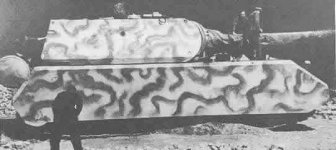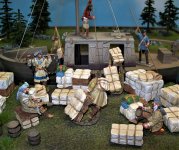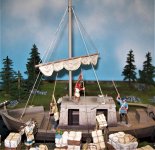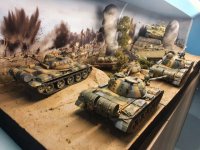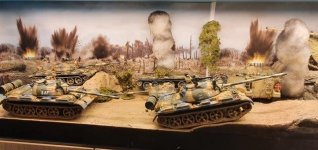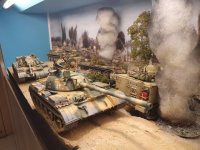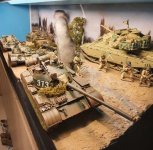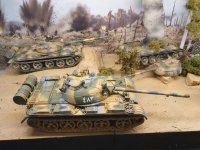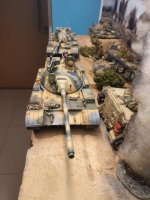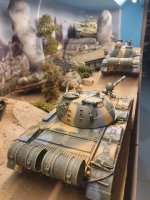Warbuff26
Sergeant
- Joined
- Apr 30, 2005
- Messages
- 665
Hello all...I came across an interesting page that had a really good description of the German Maus Heavy Tank! I know we already have a good assortment of German armor...but if we keep talking "Limited Editions" this is what I have in mind! This would top off any German Armor display! Thank god the war ended before this monster appeared! 
On June 8, 1942, Dr. Ferdinand Porsche was asked, by Hitler, to work on a new design that would carry a 128 mm or 150 mm gun in the turret with a 75 mm coaxial gun. Porsche was the head of the German Tank Commission and advocated superheavy tanks. The tank was first referred to as the Mammut (Mammoth) and given project Number 205
Alkett began assembly of the tank on August 1, 1943. Krupp supplied the hull in the middle of September 1943. The name was changed to Maus and was first run at Alkett on December 23, 1943. The tank was then sent to Böblingen (near Stuttgart) on January 10, 1944, for extensive tests. There were some problems with the suspension but the trials went rather successfully.
Hitler then ordered that the tank had to be completed by June 1944. On June 9, 1944, the turret was fitted to the tank. At the beginning of October the Maus was then sent to the proving grounds at Kummersdorf. A 2nd prototype was sent to Kummersdorf before trials were completed. This one had a different engine and considerable trouble. There were approximately 9 prototypes in various phases of completion when the war ended.
Electrical equipment came from Siemens-Schuckert and the engine was from Daimler-Benz. Tracks were supplied by Altmärkische Kettenfabrik. Armor came from Krupp, and the assembly was done by Alkett.
The Maus would have needed special rail cars designed for it's transport. Although it couldn't cross any bridges it would have been made to submerge for river crossings.
The chassis was filled with the engine except for a compartment in the front for the driver and co-driver. Fuel was located in front of the superstructure. The ammunition was carried in the middle on the left, and on the right was an auxiliary engine with additional ammunition. The electric drive motors were at the rear with the engine located in the front part of the hull.
The turret alone weighed 50 tons. It was made from a cast front, with rolled armor on the sides and rear. A grenade projector was to be installed in the roof. The turret was electric powered and was to make a full rotation in 16 seconds.
The 8 hp auxiliary engine provided starting power, maintained the high pressure in the fighting compartment, and charged the batteries.
There were 24 double rollers combined in 12 bogies, with 6 being on each side. The bogie was hung from a cross bar fixed to the hull and the apron. Each pair of rollers sat on a double rotary arm which was sprung with a helical spring.
On June 8, 1942, Dr. Ferdinand Porsche was asked, by Hitler, to work on a new design that would carry a 128 mm or 150 mm gun in the turret with a 75 mm coaxial gun. Porsche was the head of the German Tank Commission and advocated superheavy tanks. The tank was first referred to as the Mammut (Mammoth) and given project Number 205
Alkett began assembly of the tank on August 1, 1943. Krupp supplied the hull in the middle of September 1943. The name was changed to Maus and was first run at Alkett on December 23, 1943. The tank was then sent to Böblingen (near Stuttgart) on January 10, 1944, for extensive tests. There were some problems with the suspension but the trials went rather successfully.
Hitler then ordered that the tank had to be completed by June 1944. On June 9, 1944, the turret was fitted to the tank. At the beginning of October the Maus was then sent to the proving grounds at Kummersdorf. A 2nd prototype was sent to Kummersdorf before trials were completed. This one had a different engine and considerable trouble. There were approximately 9 prototypes in various phases of completion when the war ended.
Electrical equipment came from Siemens-Schuckert and the engine was from Daimler-Benz. Tracks were supplied by Altmärkische Kettenfabrik. Armor came from Krupp, and the assembly was done by Alkett.
The Maus would have needed special rail cars designed for it's transport. Although it couldn't cross any bridges it would have been made to submerge for river crossings.
The chassis was filled with the engine except for a compartment in the front for the driver and co-driver. Fuel was located in front of the superstructure. The ammunition was carried in the middle on the left, and on the right was an auxiliary engine with additional ammunition. The electric drive motors were at the rear with the engine located in the front part of the hull.
The turret alone weighed 50 tons. It was made from a cast front, with rolled armor on the sides and rear. A grenade projector was to be installed in the roof. The turret was electric powered and was to make a full rotation in 16 seconds.
The 8 hp auxiliary engine provided starting power, maintained the high pressure in the fighting compartment, and charged the batteries.
There were 24 double rollers combined in 12 bogies, with 6 being on each side. The bogie was hung from a cross bar fixed to the hull and the apron. Each pair of rollers sat on a double rotary arm which was sprung with a helical spring.


